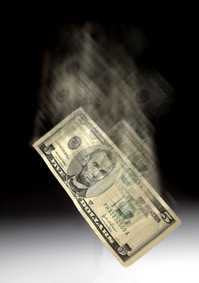By Shigeki Nozawa

The dollar may fall below 75 yen next year as it becomes the world’s “weakest currency” due to the Federal Reserve’s monetary-easing program, according to JPMorgan & Chase Co.
The U.S. central bank, along with those in Japan and Europe, will keep interest rates at record lows in 2011 as they seek to boost economic growth, said Tohru Sasaki, head of Japanese rates and foreign-exchange research at the second-largest U.S. bank by assets. U.S. policy makers may take additional easing steps following the $600 billion bond-purchase program announced this month depending on inflation and the labor market, he said.
“The U.S. has the world’s largest current-account deficit but keeps interest rates at virtually zero,” Sasaki said at a forum in Tokyo yesterday. “The dollar can’t avoid the status as the weakest currency.”
The Fed said on Nov. 3 it will buy $75 billion of Treasuries a month through June to cap borrowing costs. The central bank has kept its benchmark rate in a range of zero to 0.25 percent since December 2008. The Bank of Japan on Oct. 5 cut its key rate to a range of zero to 0.1 percent and set up a 5 trillion yen ($59.9 billion) asset-purchase fund.
The dollar traded at 83.38 yen as of 12:04 p.m. in Tokyo after falling to a 15-year low of 80.22 on Nov. 1. The greenback declined to post-World War II low of 79.75 yen in April 1995. The U.S. currency has declined against 12 of its 16 most-traded counterparts this year, according to data compiled by Bloomberg.
Tightening Unnecessary
There’s no need for any monetary tightening in the U.S. as even prolonged easing won’t heighten inflationary pressures with the balance sheets of banks and households still hurting from the fallout of the global financial crisis, Sasaki said.
Ten-year Treasury yields may decline to around 2.25 percent over the next year, and their premium over similar-maturity Japanese yields won’t widen, he said. The benchmark 10-year Treasury yielded 2.89 percent today.
The world economy is likely to expand 3 percent next year amid the extra liquidity provided by central banks, “repeating a pattern from early 2002 to the end of 2004” when improving risk appetite boosted stocks and commodities and the dollar fell 25 percent against the yen, Sasaki said.
With monetary easing in the U.S., Japan and Europe likely to bolster the global recovery and increase demand for yield, the yen is poised to weaken against other currencies beside the dollar to levels last seen in early 2007, Sasaki said.
Japan will refrain from selling the yen even if it strengthens against the dollar, following international criticism of foreign-exchange intervention, he said. The nation intervened in the currency markets for the first time in six years on Sept. 15 when the yen climbed to a 15-year high.
To contact the reporter on this story: Shigeki Nozawa in Tokyo at [email protected].
To contact the editor responsible for this story: Rocky Swift at [email protected]
https://www.bloomberg.com/tosv2.html?vid=&uuid=90a3d4d1-d357-11ed-9133-55546f6d5541&url=L25ld3MvYXJ0aWNsZXMvMjAxMC0xMS0xOC9kb2xsYXItdG8tYmVjb21lLXdvcmxkLXMtd2Vha2VzdC1jdXJyZW5jeS1kcm9wLXRvLTc1LXllbi1qcG1vcmdhbi1zYXlz, Nov 18, 2010

Leave a Reply